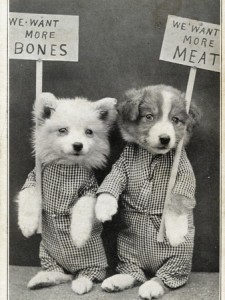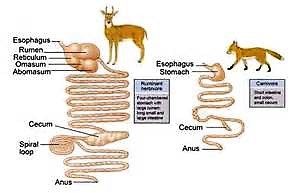The Scoop On Raw Feeding
 There is no such thing as “premium kibble” or “holistic pet food.” Commercially processed dog and cat food cannot be biologically adequate food for a carnivore.
There is no such thing as “premium kibble” or “holistic pet food.” Commercially processed dog and cat food cannot be biologically adequate food for a carnivore.
Here are just a few facts:
1. Commercially ultra-processed dog and cat dry food contains maximum 10% water. Natural raw food contains about 75% moisture.
2. Kibble contains about 40-60% carbohydrates, mainly from the overwhelming amount of grain in the product. Natural raw food contains none! Carbs and starches can also come from vegetables, such as, potatoes and yams, often used as a substitute for grains and used as fillers.
3. All commercial dog and cat food is cooked at high temperatures. Natural food has never been heated (Please note: Meat cooked at 117F degrees for only 3 minutes will become denatured. Heat destroys all live enzymes, essential amino acids, and including most micronutrients. That’s why synthetic vitamins have to be added to commercial pet food).
4. All commercial dog and cat food is preserved with poisonous chemicals. If not, it would perish in a matter of hours.
I can promise you:
• Feeding a raw meaty bone diet will make sense once you educate yourself
• Quality raw food is not more expensive than “quality kibble”
• Your dog or cat’s health will improve visibly when you change to raw
• Raw meaty bone diets do not make a dog vicious or blood-thirsty; but not feeding it might
• Feeding a raw meat diet becomes easy and simple when you fully understand why you should be feeding a raw meat diet
I cannot give you a complete education on raw feeding through a couple of blogs on my website. The topic is too big. But I hope I can make you understand that this is an area where you as a responsible dog/cat owner have no choice about educating yourself. You are simply not a responsible pet owner if you do not take the time to learn how you should feed your dog or cat a natural diet. The people who tell you that commercial dog/cat food is “just fine” are either completely uneducated about carnivore nutrition and simply do not know what they are talking about, or they have a financial interest.
I have seen in many on-line forums how people who are new to the concept of raw feeding run into serious problems because they only understand a fraction of what they should understand. Thus, they make some terribly wrong decisions or get seriously confused. Trying to gather a good understanding of this vast topic by simply reading a few posts in a forum is not very diligent, to put it mildly. Forums are great when you understand the basics and can assess and evaluate the information you receive. But, until then, newsgroups are more confusing than enlightening. And I’ve seen some discussions on these forums where the information exchanged is so incorrect that I’ve literally cringed. Please remember, those members are not skilled educators. They are “ordinary” people who have had some personal experiences with raw feeding, many of them only for some months or some years. Now, this does not make their experiences inadequate or wrong. Rather their advice are just not complete!
There are two ways to get a good understanding of how you can manage feeding your dog or cat a species appropriate diet:
1. You can study the dog and the cat’s natural prey and its hunting behavior, or
2. You can study the dog and the cat’s physiology, anatomy, and body chemistry.
Both will lead you to the same conclusion and the same fundamental recipe for what “dog & cat food” should be: raw meaty bones and organs.
How Holistic Vets Can Cause Confusion About “Raw Feed”
Now, I need to say a word regarding a few of the books I’ve seen on the subject of “holistic health care for cats and dogs.” They, too, can be confusing and filled with cringe-worthy advice. There’s one book I’m thinking of in particular that was written by a world-famous veterinarian. I was skimming through his book and agreeing with everything he said about cats and dogs being a carnivore and eating a raw meat diet. That is, until I got to the “recipes for cats & dogs” chapter. There was a recipe for cats that included stuff like rice (grain), veggies (for an obligate carnivore?), canola oil (Omega-6. Most canola oil is Genetically Modified which increases its oleic acid content), and table salt (huh?), and a little bit of raw meat. Where’s the calcium? Minerals? Omega-3s? Taurine? Essential fatty-acids? Needless to say, I closed the book in disbelief.
The thing is folks read these books and because it’s written by a world-famous veterinarian they automatically trust his advice on diet. But, then I’ll get emails from people who read these books and become confused (even the average pet owner knows canola oil is outrageous) and ask me what the real deal is (I later found out this world-famous vet is a vegan, which I don’t have a problem with. But I do have a problem when one imposes a vegan/vegetarian diet on meat-eating animals).
I know there are some veterinarians out there who believe dogs are omnivores. This is what they are taught in vet school. But then you have to ask yourself: who teaches the nutritional course at these vet colleges? (btw, only one voluntary 5-day-class on nutrition is taught to these vet students). Well, I’ll tell you: Nutrition is taught by a representative from the pet food industry. The rep walks into class with bags of kibbles and canned food and teaches the vet students how to read the labels. And, that, my friend, is the extent of the 5-day nutrition class. Of course, they want you to believe a dog is an omnivore because if you read the ingredients on their dog food you’ll see it’s full of fruit, veggies, grains, and a little bit of cooked meat. Basically, grains and starches are used as fillers, and veggies/fruit is to appeal to the pet owner’s idea of what a nutritionally balanced meal should look like (maybe for a human, that is. Not for a dog).
The Dog: Omnivore or Carnivore?
All veterinarians will agree the cat is an obligate carnivore. Studies have shown the cat family relies on a narrow set of 1,376 genes linked to strong muscle fibers and the digestion of protein. But, there seems to be quite a controversy on whether a dog is a carnivore or an omnivore. As a matter of fact, the disagreement between that thought can be very passionate.
Recently, I noticed that two well-known natural animal health personalities, one a veterinarian who writes a blog for a top holistic website and the other who is an editor for a magazine on natural dog health, have stopped using the term ‘Raw Food,’ but instead, use ‘Fresh Food.’ This is so they can push vegetables and cooked meat in their recommended diet plans for cats and dogs. All of this falls nicely in line with the pet food industry’s audacity to change dogs from carnivores to omnivores with zero proof. Whose side are these people on?
Now, the explanation I’ve heard from some veterinarians as to why they believe a dog is an omnivore is, as follow:
The dog has been domesticated for 10,000 years. And in that time, it has learned to adapt to the human diet.
Oh, really? Where’s the proof? Where’s the science? Commercial pet food has only been around since the 1890s. That’s not long enough time for the canine physiology to evolve into an omnivore. Before the industrial revolution and the creation of the middle class only the rich could afford to have cats and dogs as pets. The common man, like, a farmer, kept cats and dogs as work animals. Dogs protected herd animals and cats protected the food supply from vermin. In those days, dogs sometimes got a few scraps from the table, but mostly it hunted its own food.
When the dog was domesticated it wasn’t to help humans plant corn in the field. The dog was used to help in the hunt. The wolf is the perfect hunter. He can track, outrun, and capture prey better than any human. So, it’s understandable why humans would want to tame the wolf. Humans weren’t looking for a pet, they were looking for a tool, a hunting companion.
Carbohydrates have no nutritional value to cats & dogs!
Now, the so-called “proof” that dogs are omnivores is Dogs have amylase just like humans and other omnivores. For those who don’t know what amylase is, it’s an enzyme that breaks down carbohydrates into sugars. I’ve read the articles where amylase is used as an argument in their attempt to prove a dog is an omnivore. But these articles failed to mention that not only does the obligate carnivore, the cat, ALSO has amylase, but WHERE the amylase is located. The omnivore has amylase BOTH in the saliva and pancreas. But the cat and dog ONLY has amylase in the pancreas. They do NOT have this enzyme in their saliva. This means, for the cat and dog digestion begins in their stomach (not in the mouth like with omnivores) and this is where proteins are broken down into smaller particles in order for amino acids to enter the blood stream. The amylase in the cats/dog’s pancreas is very limited and can only handle a small percentage of carbs/starch, e.g., approximately 6% in dogs, and approximately 1% to 3% in cats.
Now, getting back to the world-famous vegan veterinarian I mentioned above. I have heard quite a few naturopathic/holistic veterinarians confront him on his promotion of vegan diets to carnivores. His answer, I paraphrase, “Yes, I know they’re carnivores. But I’m trying to save the planet.” And then he’ll cite an article from The Nature Journal claiming dogs have somehow learned to “activate their gene sequence” in order to produce as much amylase as humans. Does he mean in the pancreas? Because science has yet to prove canines are now making digestive enzymes in their saliva like herbivores or omnivores. And if dogs have “evolved” to produce more amylase in their pancreas then why is there an epidemic of pancreatitis and diabetes amongst the domesticated dog population?
I read the article the vegan vet was referring to (and you can read it HERE) and it’s all theories (aka assumptions). The article does not present evidence, such as, lab analysis or controlled experiments. When I read stuff like this the first thing that pops into my mind is “who’s financing this research?” My first suspicion is the Pet Food Companies.
I realize the above-mentioned veterinarian is passionate in his ideology of “saving the planet.” But when I heard him give the reason for feeding vegan diets to cats and dogs is because prey animals don’t want to die and I’m saving them from meat-eaters, he lost all credibility to me. I got news for you: agricultural kills more animals than any slaughterhouse. Billions of field mice, rabbits, birds, moles, and trillions of insects are killed in the wheat and soy fields. There are many species of birds that lay their eggs on the ground hoping their nests are safe in the tall wheat stalks. Mama deer hide their newly born fawns in the farmers’ fields only to be slaughtered by the steel blades of the tractor.
I’ve looked for research that claim dogs have “evolved” away from a carnivore diet and can now thrive on vegetarian/vegan diets. And, guess what? I can’t find one. Not one! However, there are studies that say that a certain fruit or vegetable has a particular compound or property that makes it good for X (reducing tumors, for example). The assertion is that we should feed it to our pets because of that compound. But what is never mentioned that I’ve been able to find is how the carnivore’s system is supposed to access that particular compound. There’s no real attention given to how the carnivore system is different from the omnivore or the herbivore.

Herbivore vs Carnivore Digestive System
Look at the illustration of the deer and the fox. Do you see the difference in their digestive tract? Look at the cecum. That organ is designed to extract salt and water from plant material. Do you see how big it is on the herbivore compared to the canine (the cats cecum is a little smaller than the dogs)? There’s a reason for this, like “Yo, I’m not supposed to eat a lot of plants. A little grass now and then is OK, but not that salad.”
Also, dogs and cats do not have the enzymes necessary to break down plant fibers (cellulose). Therefore, they cannot absorb nutrients from plants. These are biological differences that are important to understand.
Cats and dogs on a vegan diet will be deprived of Omega-3s. Dogs cannot make sufficient amount of Omega-3s from hemp oil, algae, or other sources of ALA. And cats can’t do it at all. Other important nutrients: Vitamin A, B6 (pyridoxal and pyridoxamine), B12, Vitamin D, F, K2. Amino acids: creatine, carnitine, carnosine, taurine. Plus, Heme-iron, CoQ10, CLA (conjugated linoleic acid).
Cats and dogs do not get their Vitamin D3 from the sun. They get it from their food: e.g., organ meats and blood. Cats cannot convert beta-carotene from veggies into bio-available Vitamin A which would be retinal. They get retinal directly from organ meats, e.g. liver. Do you really think synthetic supplements made in a lab is a good substitute? All of these nutrients are only found in animal products.
The Benefits Of A Raw Diet
A species appropriate diet of a raw meat is the healthiest form of pet food. Here are just some of the benefits:
Smaller stools: That’s because a raw diet is absent of fillers from processed foods. Stools are easier to pass and this helps to express the anal glands once it exits.
Better gut health: Raw meat is full of digestive enzymes which are absent in over-cooked processed pet food.
Behavioral benefits: Helps to support neural transmitter production, like, seotonin and tryptophen.
Less allergies: Especially if you start puppies on raw meat as soon as they are weaned.
Soft, shiny fur: Raw meat contains essential fatty acids.









